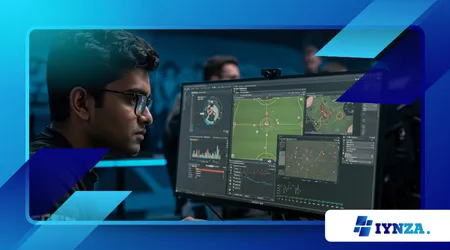Cómo se utiliza la IA en el entrenamiento de esports (y qué puedes aprender de ella)

El entrenamiento tradicional siempre se ha basado en la observación, la intuición y la experiencia. Los entrenadores ven repeticiones, ofrecen consejos generales y esperan que los jugadores asimilen sus comentarios. Pero La IA se utiliza en el entrenamiento de deportes electrónicos Introduce una poderosa capa de precisión que cambia el juego por completo.
Anuncios
La IA no solo observa: registra y analiza cada fotograma, cada acción, cada variable.
Al procesar grandes conjuntos de datos de los partidos, la IA identifica patrones que los humanos suelen pasar por alto. Puede detectar microerrores, como un ligero retraso en el tiempo de reacción o una tendencia a rotar demasiado pronto. Esta información permite a los entrenadores diseñar planes de mejora personalizados, centrándose en puntos débiles específicos. En lugar de consejos vagos, los jugadores reciben retroalimentación práctica como "mejorar el tiempo de observación en un sitio" o "ajustar la posición de la mira a mitad de ronda".
Este cambio implica que los jugadores mejoran más rápido y de forma más consistente. La IA no reemplaza la intuición humana, sino que la potencia. Los entrenadores se convierten en estrategas basados en datos y los jugadores en aprendices más eficientes. Es una alianza entre la intuición y la información, y los resultados hablan por sí solos.
Cómo los modelos de IA decodifican la jugabilidad y el comportamiento a nivel micro
La belleza de la IA en los esports reside en su capacidad para descomponer la jugabilidad en unidades pequeñas y digeribles. Las herramientas modernas de IA evalúan cada segundo de una partida mediante visión artificial, análisis de audio y etiquetado de eventos. Trayectorias de movimiento, precisión del cursor, pulsaciones de botones: cada acción se vuelve medible.
Estos datos se comparan con estrategias óptimas, lo que permite a la IA detectar ineficiencias. Por ejemplo, las granadas aturdidoras de un jugador podrían impactar un segundo más tarde que las de los profesionales.
O quizás sus decisiones económicas se desvían de las metatendencias, lo que provoca una pérdida de impulso. La IA detecta estos momentos y los informa al instante.
Los sistemas más avanzados incluso agrupan los errores por tipo. Podrías descubrir un patrón: un mal posicionamiento tras la plantación o un exceso de compromiso en los duelos iniciales. Con esta claridad, ya no tendrás que adivinar por qué perdiste una ronda. Ya lo sabes.
¿El resultado? Un plan para la mejora. La IA transforma el ensayo y error en iteraciones específicas, eliminando el esfuerzo innecesario y acelerando el desarrollo de habilidades. No se trata de trabajar más duro, sino de trabajar con más inteligencia.
Lea también: Las mejores listas de reproducción para escuchar mientras juegas
Cómo aplicar los principios del coaching de IA a tu juego sin herramientas costosas
No es necesario acceder a tecnología de vanguardia para beneficiarse de los principios de la IA. Muchas de las ideas centrales detrás... La IA se utiliza en el entrenamiento de deportes electrónicos se puede aplicar manualmente.
Empieza grabando tus partidas y analizando las imágenes con un propósito. Céntrate en los momentos en los que moriste o tomaste decisiones cuestionables. Pregúntate: ¿Cómo fue mi timing? ¿Fallé en la puntería o fallé en mi decisión? ¿Fueron eficaces mis servicios públicos? Luego, crea una hoja de cálculo sencilla para registrar los errores recurrentes.
A continuación, diseña ejercicios de entrenamiento que reflejen esos problemas. Si tu puntería es débil, usa entrenadores de puntería. Si te falta conocimiento del mapa, revisa vídeos profesionales o realiza recorridos de mapa en solitario. La clave está en la repetición con intención.
Además, aprovecha la retroalimentación. Usa las reseñas de pares o las comunidades de Discord para obtener diferentes perspectivas. Los sistemas de IA prosperan con grandes conjuntos de datos; los humanos se benefician de la diversidad de opiniones. Combina ambos y simularás el ciclo de retroalimentación de la IA en tu propio entorno.
Lo que los entrenadores descubren con la IA y que la mayoría de los jugadores nunca ven
Los entrenadores que usan IA obtienen visibilidad sobre aspectos del juego que la mayoría de los jugadores pasan por alto. Patrones de fatiga, inconsistencias en el tiempo y sobrecarga cognitiva: todo se vuelve rastreable.
¿Los reflejos de algún jugador bajaron tras 45 minutos de práctica? ¿Empezaron a fallar los tiros de humo después de dos partidos consecutivos? La IA responde a estas preguntas.
Esto conduce a regímenes de entrenamiento más inteligentes. Los entrenadores ajustan los calentamientos, los descansos y las estrategias del equipo según tendencias objetivas. Si un jugador rinde mejor de forma consistente en sesiones cortas, el equipo podría reestructurar las prácticas en consecuencia.
La IA también detecta indicadores de inclinación, como una comunicación deficiente o una toma de decisiones demasiado agresiva. Estas señales ayudan a los entrenadores a intervenir antes de que el rendimiento disminuya aún más.
En definitiva, se trata de crear hábitos. El buen juego se convierte en algo natural, no en algo accidental. La IA garantiza la consistencia, no solo la excelencia.
Lo que el futuro del entrenamiento con IA en los deportes electrónicos podría significar para todos
El futuro del entrenamiento con IA en los esports va más allá de reacciones más rápidas o punterías más precisas. Se trata de liberar todo el potencial del jugador: técnico, mental y emocional.
Imagina sistemas de IA que no solo analicen tu juego, sino que también comprendan tú Como jugador: cómo piensas, cuándo te inclinas y qué te ayuda a reiniciarte.
Estas herramientas podrían monitorizar la biometría, detectar el aumento de la frecuencia cardíaca o el estrés mediante los movimientos del ratón y recomendar descanso antes de que el rendimiento disminuya. Es como tener un entrenador que nunca duerme y siempre sabe qué necesitas.
Los sistemas adaptativos redefinirán nuestra forma de entrenar. Ya no tendrás que pasar horas practicándolo todo. En cambio, la IA personalizará los calentamientos según tus debilidades.
Quizás tu tiempo de reacción fue lento ayer; hoy, tus ejercicios empiezan con entrenamiento de reflejos. Quizás tu percepción del mapa era deficiente; ahora practicarás con escenarios con posiciones enemigas generadas por la IA.
Incluso para quienes no pertenecen al ámbito profesional, el impacto es enorme. Más jugadores tendrán acceso a retroalimentación de nivel de entrenador, algo que históricamente estaba reservado para equipos profesionales o campamentos de entrenamiento de élite.
El techo de habilidades no sólo aumentará, sino que se ampliará, empoderando a una nueva generación de jugadores más inteligentes y conscientes de sí mismos.
Preguntas frecuentes: IA utilizada en el entrenamiento de deportes electrónicos
1. ¿Puedo beneficiarme del coaching de IA sin estar en un equipo profesional?
Sí. Muchos principios, como revisar el metraje, registrar patrones y corregir errores, se pueden aplicar manualmente o con herramientas asequibles.
2. ¿Existen herramientas de IA gratuitas o de bajo coste para los jugadores?
Sí. Herramientas como Aim Lab, Tracker.gg y la API de Valorant ofrecen análisis que puedes usar para mejorar tus habilidades sin gastar una fortuna.
3. ¿Qué tan preciso es el coaching de IA en comparación con los coaches humanos?
La IA destaca por detectar patrones y proporcionar datos objetivos. Los coaches humanos siguen siendo esenciales para la estrategia, la motivación y la dinámica de equipo. El mejor enfoque es usar ambos.
4. ¿La IA ayuda con la mentalidad dentro del juego o solo con la mecánica?
Ayuda a ambos. Algunas herramientas de IA ahora rastrean datos de comportamiento, lo que proporciona información sobre la inclinación, la fatiga y el estrés. Se espera que este sector crezca rápidamente.
5. ¿La IA eventualmente reemplazará a los entrenadores de deportes electrónicos?
Improbable. La IA proporciona datos, pero los coaches aportan significado. La combinación de ambos crea la ruta de desarrollo más efectiva.
6. ¿Cómo integran actualmente los equipos la IA en su rutina?
Utilizan IA para revisar las prácticas, evaluar a los oponentes y planificar ejercicios. Esto optimiza la retroalimentación e identifica áreas de mejora más rápido que la revisión manual.
7. ¿Qué pueden aprender los jugadores individuales de los métodos de entrenamiento de la IA?
Los jugadores individuales pueden adoptar una autoevaluación estructurada, realizar un seguimiento de métricas clave y desarrollar ejercicios específicos, imitando el ciclo de retroalimentación de la IA para el crecimiento personal.
